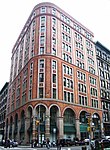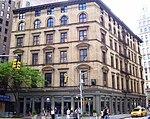The Sound Factory was a nightclub first located 532 West 27th Street and then 618 West 46th Street in New York City's Manhattan. The Sound Factory Bar was an offshoot at 12 West 21st Street. The club was originally called Private Eyes which was a very popular nightspot in the late 1980s and the early 1990s that for its time had an unusually advanced state of the art video and sound system. Private Eyes catered to a variety of growing underground music scenes in its heyday.
In the mid 1990s Private Eyes was then purchased by 2 of the 3 owners of The Sound Factory, and, since the space was smaller, it was renamed the Sound Factory Bar. The club was an integral venue during a peak period of house music in New York. Wednesdays housed the recently resurrected Underground Network parties, hosted and promoted by recording artist Barbara Tucker and Don Welch, with Grammy Award winner Little Louie Vega as resident DJ. On Thursday nights, "Factoria 21," a tribal house gay night with DJ Merritt and Lord G, and on Friday nights, "Godfather of House" Frankie Knuckles helmed the decks. On Sunday afternoons, it was the host for "Body Positive Tea Dances," (a social for HIV positive men and their friends); the DJs were Mark Cicero and Mark Thomas. Closing out the weekend on Sunday evenings, "Purgatory" a tribal and progressive house gay night with DJ Merritt and DJ Andrew Tonio. One of the most notorious events was a weekly party called MILK Mondays from DJ TPromix that after several years at this location went on to thrive for 9 years around the city. Also, (in the latter Cheetah years) Cafe con Leche, Cafe Futuro, and Asseteria were weekly Sunday parties.
Other prominent DJs, artists, and parties appeared at the club as well during this time.








